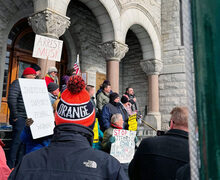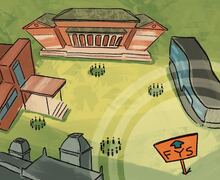Iconic wooden bat brand originally crafted in Syracuse is making a comeback
Joe Bloss | Asst. Copy Editor
Kren's Special baseball bats have been used by some of the best hitters in the game, including Babe Ruth.
Scuffs cover the barrel of a wooden baseball bat. Its handle shines with the polish provided by the countless fingers that have gripped it, its knob engraved with the letters “SU,” its top end blackened by all the times it was put down in the dugout more than half a century ago.
All of these characteristics take a backseat, though, when compared to the name burned into the shaft of the bat.
“Kren’s Special.”
It’s a name that left an indelible mark on baseball history from right here in Syracuse. But it doesn’t carry nearly the same recognition as a Louisville Slugger.
This particular bat, found in the Syracuse University archives, is believed to have belonged to Donald E. Merrow. Merrow was a graduate of the College of Business Administration, now the Martin J. Whitman School of Management, back in 1941. A neat artifact from SU sports’ past, but just a drop in the ocean of the millions of bats crafted by Joseph G. Kren.
Kren’s bats were used by some of the best hitters to ever play the game: Babe Ruth, Lou Gehrig, Honus Wagner, Frank Frisch and Rogers Hornsby, just to name a few. For the first half of the 1900s, Kren hand-turned bats with a mastery others couldn’t come close to. What took most three hours he could do in 15 minutes.
It’s that high level of quality Robert Rosenberg is trying to bring back to the sport he loves. About a year ago Rosenberg, president of Harpen Brand Holdings, LLC of West Long Branch, New Jersey, acquired the rights to the Kren brand.
He’s already introduced his version of “Kren’s Specials” to some independent league hitters. And if everything goes right with getting MLB approval, it could be a more than $50,000 annual investment that brings the Kren name back to the big leagues.
“We’re not looking to replicate the same exact bats,” Rosenberg said. “We’re just using the brand as a way to educate people on the history of this iconic brand and to make bats of the highest quality.”

Joe Bloss | Asst. Copy Editor
Rosenberg said he’s working with a top bat manufacturer to produce the bats. Once they build up enough of a following, and get licensing, insurance and manufacturing logistics approved by the MLB, the bats will be legal in the minor leagues. With success there, the hope is players will then continue to use Krens as they’re called up to the majors.
Reviving old brands isn’t new to Rosenberg. Early last year, he did the same for the Esterbrook pen brand — which last year he told USA Today was the fifth trademark ever issued in the United States. He sold the Conklin Pen Co. in 2009.
These restoration projects have become somewhat of a regularity for Rosenberg since studying intellectual property trademarks in law school. And if he succeeds again, this time infiltrating a tight wooden bat market, Ron Gersbacher will be surprised.
“Good Luck,” Gersbacher said.
Ron Gersbacher was the first and only man to ever serve as team historian of the Syracuse Chiefs. He held the position from 1985 to 2014, and spent five of those years as the team’s president. A native of Syracuse’s north side, he knew Kren’s sons well.
“I’ve probably spent more time with his family than anybody,” he said.
Gersbacher was born just a few years before Kren died. But ask a question about anything Kren, and he’ll probably be able to confirm or deny. He’s done a “biography by manufactured bat numbers.” He knows his stuff.
According to a 1931 article in the Syracuse Herald, Kren was born in Vienna in 1868, and came to America in 1887 after serving as a wood turner’s apprentice in Germany. He married in 1896 and would have four sons — Henry, Frank, Joe and Walter — but he also fell in love with America’s pastime.
Kren worked at a manufacturing company. Gersbacher spoke of how during lunch breaks, Kren would craft bats for the kids playing outside with mere sticks. Eventually the secret got out that this man made a bat better than most everyone else. SU and the Syracuse Stars — a St. Louis Cardinals farm team — began using Kren bats.
In 1913, Kren had enough of a clientele that bat turning could become a full-time gig. The Kren Bat Company was born. For 40 years, Kren, his sons and a few hired hands became small but strong players in the wooden bat market. They gave Louisville Slugger a run for its money, making sometimes upwards of 100,000 bats in a year, according to Kren’s obituary in the Post-Standard.
Basic research into the company’s history will tell you that operations were run in the factory built in the Krens’ backyard at 114 Beecher St. Clips from the Herald will tell you that the factory tragically burned down overnight in a 1939 fire, accruing $25,000 in losses and putting Kren Bats in jeopardy. Luckily, the company was able to move to a building at 212 Bear St. and continue producing bats, and even police billy clubs, for several more years.
But that research won’t tell you what made that rekindling of the business possible. Gersbacher will.
“As soon as Louisville Slugger, which was of course the main manufacturer of bats in America, heard of their loss, Louisville automatically shipped them a truck load of wood to put them back in business,” Gersbacher said.
“I remember Mr. Kren (Joseph’s son) telling me that through the kindness of Louisville’s heart — because (the Krens) were a good competitor, not a big competitor — they put them back in business again very quickly,” Gersbacher said. “That’s an unbelievable story and when I heard of it I went, ‘Ha, that’ll never happen again.’ It’s amazing it happened the first time.”
Ironically, it’s Louisville Slugger that might have contributed to why Kren isn’t a household name today. Contracts existed that didn’t allow players to pose and often play with other bats, so Kren never really had a chance to reach the level of a Louisville Slugger.
But that didn’t fully stop some of the game’s heroes from taking swings with Kren’s Specials. A Jan. 15, 1927 headline in the Syracuse Herald reads “Babe Ruth Homers Are Born Here.” Some stories claim that when The Bambino broke his bat, he would mail it to Kren, and Kren knew that meant he needed to send Ruth a new one.
Connie Mack’s Philadelphia Athletics were some of Kren’s most loyal customers. The September 1951 edition of The Sporting Goods Dealer claimed, “Mr. Mack’s famous Million Dollar infield — Frank (Home Run) Baker, Stuffy McInnis, Eddie Collins and Jack Barry — all did their clouting with Kren bats.”
These legendary endorsements are a crucial part of the legacy that’s tied to the Kren name today. Some of the bats can be worth a nice sum of money. Brian Magee, a collector of Syracuse antiques, owns some of the less valuable Kren pieces still around. He lives right around the corner from the Bear Street factory where the bats were made, and still remembers the feeling of when he randomly stumbled upon the story of the Kren family.
“As soon as I saw that there was a bat manufacturer and these bats were reportedly used by Babe Ruth and Lou Gehrig and Ty Cobb — just humongous, larger-than-life sports heroes from before my time — it sparked almost a super interest into it,” Magee said.
As a Camillus, New York native who loves baseball, he developed an emotional attachment to the bats. He needed to know more.
“There is a lot of little things that have happened in Syracuse, and there’s a lot of weird little things that happened for a fraction of time and there really isn’t as much recorded information about it as you’d think,” Magee said.
And there’s a reason Kren history hasn’t fully survived the test of time. Over the years, many bats were simply burned as firewood. When Kren died at the age of 86 in 1953, his sons sold the company a short time later. They got rid of thousands of remaining bats, and donated his tools to the National Baseball Hall of Fame in Cooperstown, New York, where they, along with six bats, still remain today.
A Post-Standard article from 1956 stated, “A major league baseball bat factory has gone into the bush leagues.” The Syracuse Floral Supply Co. bought the Bear Street property.
It’s a legacy David Haas, the man behind the Syracuse history Instagram account, would like to see publicized in more places than just baseball’s greatest shrine. He recently posted a series of pictures about Joseph Kren, and was stunned to find that the current owner of the original Kren property at 114 Beecher St. was totally unaware of the story sitting on his land.
“There is no historical sign at either (Kren’s) old home or the old warehouse,” Haas said. “It would be cool to get one from the state or the city to just indicate the history and all his accomplishments that state Joe was able to get all these athletes into our city to buy his homemade product.”
That’s not to say that Kren’s adopted city hasn’t given him the praise he deserves. Two years before he died, he was honored as the Man of the Year by Holy Trinity parish. Big names came to commend him: Mack, Wagner and boxing champions Jack Dempsey and Gene Tunney were among those in attendance. In 2000, Kren was posthumously inducted into the Greater Syracuse Sports Hall of Fame.
Gersbacher, who brought Kren’s son Joe to the enshrinement of his father in 2000, wanted to make clear that the older Joseph Kren was anything but average.
Said Gersbacher: “It’s a great story, it’s a great family, and it just ties these people to some of the biggest names in baseball.”
Published on October 4, 2016 at 9:36 pm
Contact: jtbloss@syr.edu | @jtbloss





